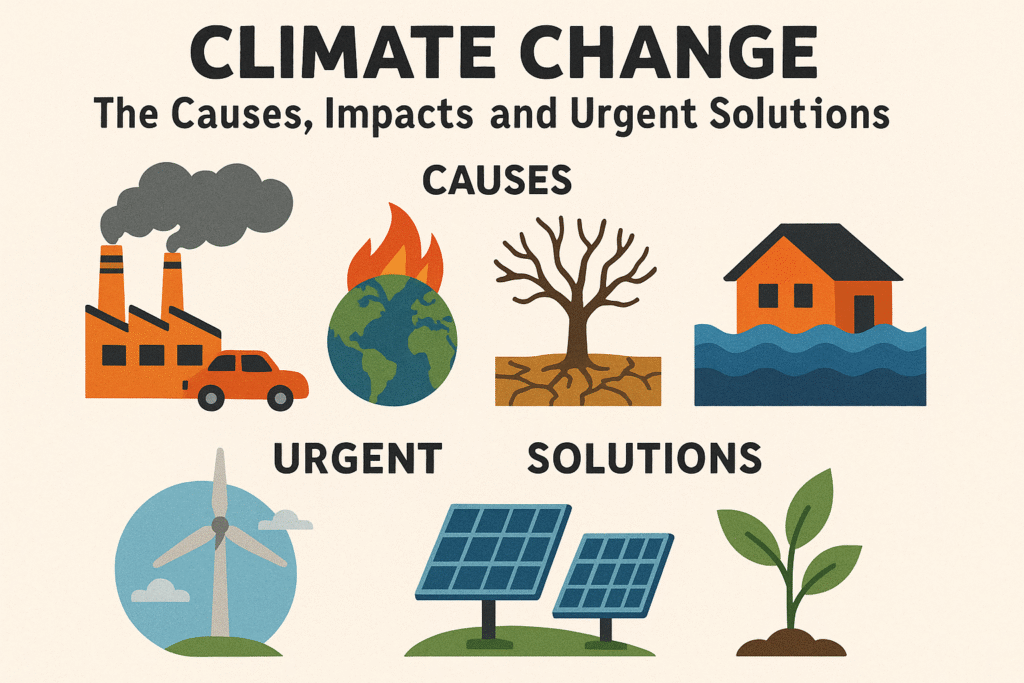Climate change is accelerating rapidly, affecting ecosystems, economies, and human health worldwide. Within the first few decades of the 21st century, the signs have become undeniable—intensifying storms, extreme heatwaves, and shifting climate patterns are no longer distant forecasts, but present-day realities. Understanding climate change is essential for informed action and sustainable solutions.

What Is Climate Change?
Climate change refers to significant and lasting alterations in global temperature, precipitation, wind patterns, and other elements of Earth’s climate system. While natural factors like volcanic eruptions and solar variations have historically influenced the climate, the current trend is primarily driven by human activities.
The main culprit? The excessive release of greenhouse gases (GHGs) such as:
- Carbon dioxide (CO₂) from fossil fuel combustion
- Methane (CH₄) from agriculture and landfills
- Nitrous oxide (N₂O) from fertilizers
- Fluorinated gases from industrial processes
These gases trap heat in the atmosphere, leading to a warming effect known as the greenhouse effect.
The Leading Causes of Climate Change
Several interrelated human activities contribute to climate change, including:
1. Burning Fossil Fuels
Power generation, transportation, and industrial activities rely heavily on coal, oil, and natural gas, which emit large volumes of CO₂.
2. Deforestation
Forests act as carbon sinks, absorbing CO₂. When trees are cut or burned, that stored carbon is released, and fewer trees remain to absorb emissions.
3. Agriculture
Livestock farming produces methane, while fertilizer use emits nitrous oxide—both potent greenhouse gases.
4. Waste Management
Improper waste disposal, particularly in landfills, leads to the release of methane and other harmful gases.
Related video embedded here: <iframe width=”100%” height=”360″ src=”https://www.youtube.com/embed/9ulbBDHxPMw” title=”Climate Change Explained” frameborder=”0″ allowfullscreen></iframe>
How Climate Change Is Affecting Our Planet
The impacts of climate change are already visible and growing more intense:
1. Extreme Weather Events
Increased heat in the atmosphere fuels hurricanes, floods, droughts, and wildfires. According to Climate Central, global heatwaves are intensifying in duration and frequency.
2. Rising Sea Levels
Melting glaciers and thermal expansion cause sea levels to rise, threatening coastal cities and small island nations. Visit STWARN’s Evacuation Planning Guide for practical steps if you live in an at-risk area.
3. Ocean Acidification
Oceans absorb CO₂, making the water more acidic. This harms marine life, especially coral reefs and shellfish.
4. Biodiversity Loss
Shifts in temperature and habitat destruction are driving numerous species toward extinction.
5. Human Health Risks
Air pollution, heat-related illnesses, vector-borne diseases, and food insecurity are all worsened by climate disruptions.
Another visual explanation embedded here: <iframe width=”100%” height=”360″ src=”https://www.youtube.com/embed/2osysX_tYe0″ title=”Impact of Climate Change” frameborder=”0″ allowfullscreen></iframe>
Climate Change in Numbers
According to Our World in Data:
- CO₂ levels are now over 420 ppm—the highest in over 800,000 years.
- The past eight years were the warmest on record.
- Arctic sea ice has declined by 13% per decade since 1980.
Solutions and What We Can Do
While the challenges are vast, many practical solutions are already within reach.
1. Transition to Renewable Energy
Investing in wind, solar, and hydroelectric power can drastically reduce reliance on fossil fuels.
2. Energy Efficiency
Improving insulation, switching to LED lighting, and using smart thermostats reduce energy waste.
3. Sustainable Transportation
Promoting electric vehicles, cycling, and public transit cuts emissions from the transport sector.
4. Climate-Smart Agriculture
Techniques like crop rotation, reduced fertilizer use, and methane capture from livestock can minimize environmental harm.
5. Reforestation
Planting trees and protecting existing forests help sequester carbon and preserve biodiversity.
Relevant internal link:
See STWARN’s Hurricane Preparedness Checklist for climate-related emergency tips.
Global Cooperation and Climate Agreements
Efforts like the Paris Agreement seek to limit global warming to 1.5°C above pre-industrial levels. Success depends on each country committing to substantial reductions in GHG emissions.
But governments alone can’t solve the problem. Cities, corporations, and individuals must all act in concert.
How You Can Make a Difference
Every action matters. Here are ways you can contribute:
- Reduce, reuse, recycle: Minimize waste and conserve resources.
- Eat sustainably: Shift to plant-based diets and reduce food waste.
- Vote wisely: Support leaders and policies focused on climate resilience.
- Stay informed: Follow reliable sources like STWARN or the National Weather Service.
Quote to Reflect On
“We are the first generation to feel the effect of climate change and the last generation who can do something about it.”
—President Barack Obama
The Road Ahead
Climate change is the defining challenge of our time. The science is clear, the consequences are real, and the time to act is now. Through local preparedness, global cooperation, and personal responsibility, we can reshape our future before it’s too late.
Want to know how storms are evolving in your area?
Visit our Weather Updates page for real-time tracking and alerts.
Useful external safety resources:
Related visual summary embedded: <iframe width=”100%” height=”360″ src=”https://www.youtube.com/embed/SLEenW2UiUw” title=”How We Can Stop Climate Change” frameborder=”0″ allowfullscreen></iframe>

